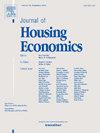Density zoning, neighborhood type, and exclusion by income and race
IF 2.4
3区 经济学
Q3 ECONOMICS
引用次数: 0
Abstract
In recent years, states and municipalities have taken steps to reform land use and zoning regulations. While prior research documents that density zoning contributes to residential segregation on the basis of income and race, the mechanisms remain largely unexplored. In this paper, we examine the relationship between density zoning, neighborhood type, and residential segregation. To do so, we use a national dataset of building footprints and machine learning to develop a neighborhood typology based on building characteristics. We then use land cover data to examine changes in building development in these neighborhoods between 2001 and 2019. Finally, we pair these data with demographics at the municipality level to examine changes in income and race between 2000 and 2020. In cross-sectional analyses, we find that density zoning is strongly associated with building characteristics and the presence of different neighborhood types. Although we find that density zoning is also associated with income and race, the effects are attenuated when accounting for neighborhood types. Our results provide new evidence into the ”chain of exclusion” between density zoning and residential segregation, as we find that density zoning is primarily associated with reductions in the supply of single-family housing along the urban fringe. Lastly, we find that maximum density restrictions and changes in maximum density cannot explain the changes in demographics that we observe during this time period. We do, however, find some evidence of a relationship between changes in building development and changes in demographics. These results demonstrate the potential effects of upzoning policies.
密度分区,社区类型,以及收入和种族的排斥
近年来,各州和市政当局已采取措施改革土地使用和分区规定。虽然先前的研究表明,密度分区导致了基于收入和种族的居住隔离,但其机制在很大程度上仍未被探索。在本文中,我们研究密度分区,邻里类型和居住隔离之间的关系。为此,我们使用建筑足迹的国家数据集和机器学习来开发基于建筑特征的社区类型。然后,我们使用土地覆盖数据来检查2001年至2019年期间这些社区建筑发展的变化。最后,我们将这些数据与市政一级的人口统计数据配对,以检查2000年至2020年间收入和种族的变化。在横断面分析中,我们发现密度分区与建筑特征和不同社区类型的存在密切相关。虽然我们发现密度分区也与收入和种族有关,但当考虑到社区类型时,这种影响就减弱了。我们的研究结果为密度分区和居住隔离之间的“排斥链”提供了新的证据,因为我们发现密度分区主要与城市边缘地区单户住宅供应的减少有关。最后,我们发现最大密度限制和最大密度的变化不能解释我们在这段时间内观察到的人口统计学变化。然而,我们确实发现了一些证据,表明建筑发展的变化与人口结构的变化之间存在关系。这些结果表明了分区升级政策的潜在影响。
本文章由计算机程序翻译,如有差异,请以英文原文为准。
求助全文
约1分钟内获得全文
求助全文
来源期刊

Journal of Housing Economics
Multiple-
CiteScore
3.30
自引率
4.20%
发文量
35
期刊介绍:
The Journal of Housing Economics provides a focal point for the publication of economic research related to housing and encourages papers that bring to bear careful analytical technique on important housing-related questions. The journal covers the broad spectrum of topics and approaches that constitute housing economics, including analysis of important public policy issues.
 求助内容:
求助内容: 应助结果提醒方式:
应助结果提醒方式:


